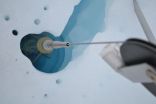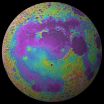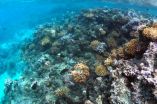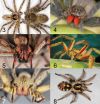(Press-News.org) Chemicals released into the air by oil and gas exploration, extraction and related activities can spark reactions that lead to high levels of ozone in wintertime, high enough to exceed federal health standards, according to new NOAA-led research, published today in Nature.
The study comes at a time when new technologies are helping to accelerate oil and gas development in Utah's Uintah Basin, elsewhere in the United States and in many other countries, and its findings may help air quality managers determine how to best minimize the impact of ozone pollution.
When ozone levels spike, Environmental Protection Agency (EPA) experts recommend that people, especially those in sensitive groups—children, the elderly, and anyone with pre-existing respiratory conditions—limit time outdoors.
Winter ozone pollution is surprising because normally, the more intense sunlight of the summer season can spark the chemical reactions that create ozone pollution, said lead author Peter Edwards, a scientist with NOAA's Cooperative Institute for Research in Environmental Sciences (CIRES) at the University of Colorado Boulder at the time of the study, and now with University of York in England.
However, Edwards and his colleagues showed that in winter in northeastern Utah, levels of volatile organic compounds (VOCs) build high enough that they can trigger pollution-forming reactions themselves. In winter, warm air aloft can trap cold air below, creating an inversion that concentrates VOCs. The presence of snow increases light reflection and accelerates ozone production. EPA estimates that 97 percent of the VOCs emitted in northeastern Utah come from oil and natural gas activities, according to the new paper.
For instance, in 2013, ozone in Ouray, Utah, exceeded the national air quality standards 49 times during the winter season. By contrast, in the densely populated, urban area of Riverside, California, the standards were exceeded about half that amount that same year, but during the summer.
"So it's the same starting ingredients, nitrogen oxides and VOCs, that form ozone in Riverside, but it's a different spark in Utah in winter," said coauthor Steven Brown, a scientist with NOAA's Earth System Research Laboratory in Boulder, Colorado. "Under wintertime conditions, the much higher VOCs in Utah break down to make carbonyl compounds, which set off the ozone production."
The research is based on data collected in a series of wintertime studies in Uintah Basin led by James Roberts, of NOAA's ESRL. "We encountered a range of conditions during the three winters, from snowy in 2013 and 2014, to virtually no snow in 2012," said Roberts. "Oil and gas emissions of VOCs were high in all three years, but high ozone occurred only in the cold, snowy stagnant periods."
Researchers from NOAA, CIRES, and other institutions made detailed measurements of ozone and the chemical ingredients, such as VOCs and nitrogen oxides, that "cook up" into the pollutant, and they used chemical models to better understand the chemistry behind the wintertime ozone formation.
"These studies in Utah have caused us to think about air pollution chemistry a little differently," said coauthor Joost de Gouw, a researcher with CIRES working at NOAA ESRL. "Our findings could help state and local air quality managers who are faced with ozone episodes to design policies, and industry representatives to meet air quality standards in the regions where they operate."
INFORMATION:
NOAA's mission is to understand and predict changes in the Earth's environment, from the depths of the ocean to the surface of the sun, and to conserve and manage our coastal and marine resources. Join us on Twitter, Facebook, Instagram and our other social media channels. Visit our news release archive.
New study explains wintertime ozone pollution in Utah oil and gas fields
2014-10-01
ELSE PRESS RELEASES FROM THIS DATE:
Evolving plumbing system beneath Greenland slows ice sheet as summer progresses
2014-10-01
AUSTIN, Texas—A team led by scientists at the University of Texas at Austin's Institute for Geophysics has for the first time directly observed multiple parts of Greenland's subglacial plumbing system and how that system evolves each summer to slow down the ice sheet's movement toward the sea.
These new observations could be important in accurately modeling Greenland's future response to climate change.
"Everyone wants to know what's happening under Greenland as it experiences more and more melt," said study coauthor Ginny Catania, a research scientist at the institute ...
Winter is coming ... to Titan's south pole
2014-10-01
Titan is unique in our solar system because of its dense nitrogen-methane atmosphere, which is very similar to Earth's in some ways, but very different in others. For example, air temperatures are around 200 degrees colder and, in contrast to the warm salt water seas of Earth, frigid hydrocarbon lakes populate Titan's surface.
Titan has seasons just like Earth, only each season lasts over seven years instead of three months due to its ponderous orbit around the Sun. After equinox in 2009, Titan's south pole entered the perpetual darkness of polar winter. Soon after, ...
Solving the mystery of the 'man in the moon'
2014-10-01
New data obtained by NASA's GRAIL mission reveals that the Procellarum region on the near side of the moon — a giant basin often referred to as the "man in the moon" — likely arose not from a massive asteroid strike, but from a large plume of magma deep within the moon's interior.
The Procellarum region is a roughly circular, volcanic terrain some 1,800 miles in diameter — nearly as wide as the United States. One hypothesis suggested that it was formed by a massive impact, in which case it would have been the largest impact basin on the moon. Subsequent asteroid collisions ...
Origin of moon's 'ocean of storms' revealed
2014-10-01
PROVIDENCE, R.I. [Brown University] — Oceanus Procellarum, a vast dark patch visible on the western edge of the Moon's near side, has long been a source of mystery for planetary scientists. Some have suggested that the "ocean of storms" is part of a giant basin formed by an asteroid impact early in the Moon's history. But new research published today in Nature deals a pretty big blow to the impact theory.
The new study, based on data from NASA's GRAIL mission, found a series of linear gravitational anomalies forming a giant rectangle, nearly 1,600 miles across, running ...
Researchers develop novel gene/cell therapy approach for lung disease
2014-10-01
CINCINNATI – Researchers developed a new type of cell transplantation to treat mice mimicking a rare lung disease that one day could be used to treat this and other human lung diseases caused by dysfunctional immune cells.
Scientists at Cincinnati Children's Hospital Medical Center report their findings in a study posted online Oct. 1 by Nature. In the study, the authors used macrophages, a type of immune cell that helps collect and remove used molecules and cell debris from the body.
They transplanted either normal or gene-corrected macrophages into the respiratory ...
New frontier in error-correcting codes
2014-10-01
CAMBRIDGE, Mass--Error-correcting codes are one of the glories of the information age: They're what guarantee the flawless transmission of digital information over the airwaves or through copper wire, even in the presence of the corrupting influences that engineers call "noise."
But classical error-correcting codes work best with large chunks of data: The bigger the chunk, the higher the rate at which it can be transmitted error-free. In the Internet age, however, distributed computing is becoming more and more common, with devices repeatedly exchanging small chunks of ...
Coral reef winners and losers
2014-10-01
Contrary to the popular research-based assumption that the world's coral reefs are doomed, a new longitudinal study from UC Santa Barbara's National Center for Ecological Analysis and Synthesis (NCEAS) paints a brighter picture of how corals may fare in the future.
An NCEAS working group reports that there will be winners and losers among coral species facing increasing natural and human-caused stressors. However, its experts demonstrate that a subset of the present coral fauna will likely populate the world's oceans as water temperatures continue to rise. The findings ...
Proving 'group selection'
2014-10-01
PITTSBURGH—The notion of "group selection"—that members of social species exhibit individual behavioral traits that render a population more or less fit for survival—has been bandied about in evolutionary biology since Darwin. The essence of the argument against the theory is that it's a "fuzzy" concept without the precision of gene-based selection.
Jonathan Pruitt, assistant professor of behavioral ecology in the University of Pittsburgh's Department of Biological Sciences within the Kenneth P. Dietrich School of Arts and Sciences, has published a paper today in the ...
New study provides key to identifying spiders in international cargo
2014-10-01
Spiders found in international cargo brought into North America are sometimes submitted to arachnologists for identification. Often, these spiders are presumed to be of medical importance because of their size or similarity to spiders that are known to be venomous.
In 2006, after witnessing multiple episodes where harmless spiders were mistaken for toxic ones, Dr. Richard Vetter, an arachnologist at the University of California, asked other arachnologists to provide data on specimens they found in international cargo that had been submitted to them for identification. ...
Scientists aim to give botox a safer facelift
2014-10-01
New insights into botulinum neurotoxins and their interactions with cells are moving scientists ever closer to safer forms of Botox and a better understanding of the dangerous disease known as botulism. By comparing all known structures of botulinum neurotoxins, researchers writing in the Cell Press journal Trends in Biochemical Sciences on October 1st suggest new ways to improve the safety and efficacy of Botox injections.
"If we know from high-resolution structures how botulinum neurotoxins interact with their receptors, we can design inhibitors or specific antibodies ...



